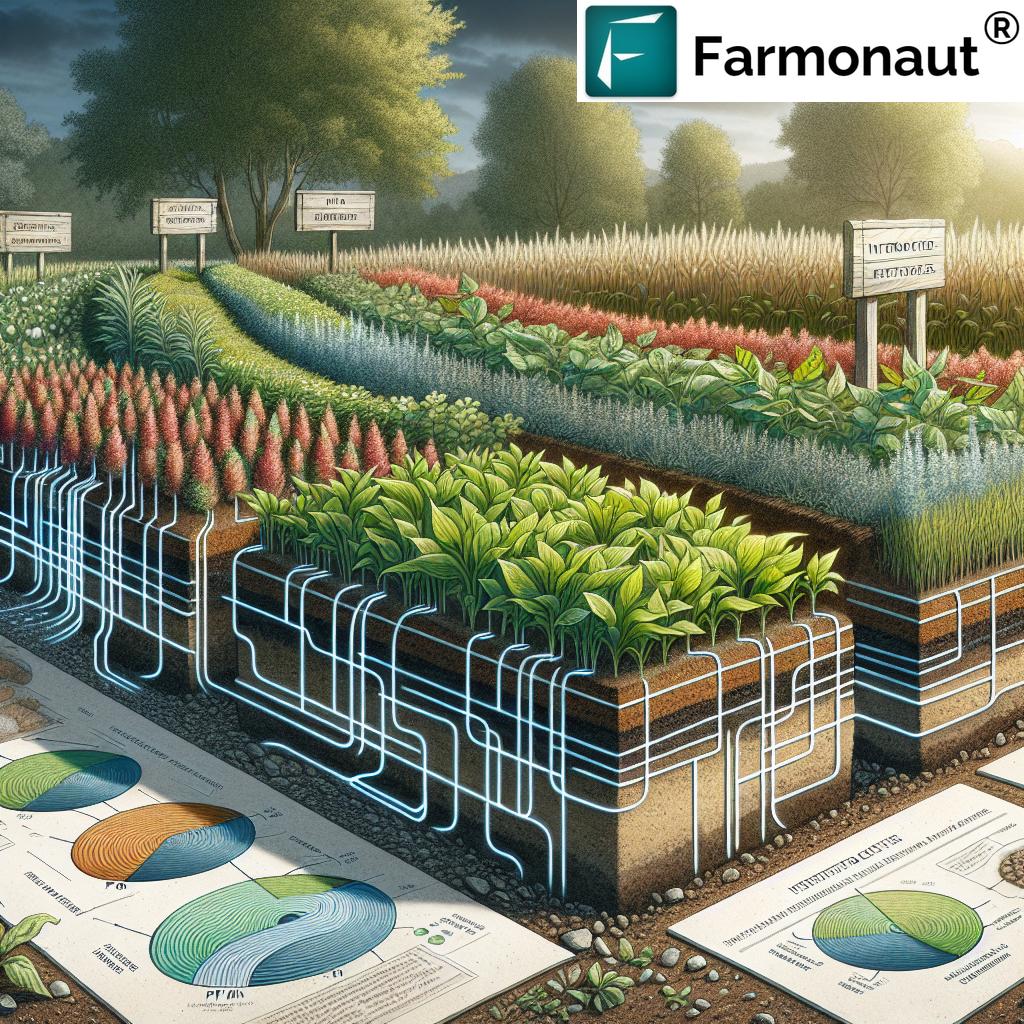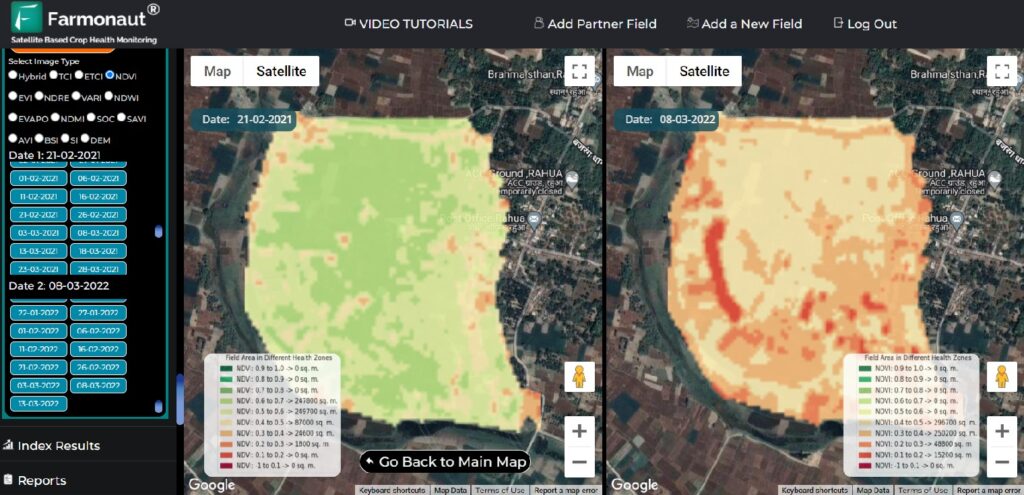Soil Fertility: 7 Powerful Ways to Boost Sustainable Growth
“Healthy soils can increase crop yields by up to 58% through improved organic matter and nutrient management.”
Table of Contents
- Understanding Soil Fertility: The Foundation of Sustainable Agriculture
- Key Components of Soil Fertility
- Factors Affecting Soil Fertility & Nutrient Availability
- Comparison Table of Sustainable Soil Fertility Practices
- 7 Powerful Ways to Boost Soil Fertility Sustainably
- Farmonaut’s Role in Improving Soil Fertility in Agriculture
- FAQ – Soil Fertility & Sustainable Growth
- Conclusion: Our Responsibility for Productive and Sustainable Soils
Understanding Soil Fertility: The Foundation of Sustainable Agriculture
At the heart of every productive farming, agricultural, and forestry system lies a vital resource often overlooked beneath our feet: soil fertility. As stewards of the land, we must recognize that fertile soil not only sustains plant growth but is also critical for sustainable food production, climate resilience, and ecosystem services. Soil fertility is defined as the capacity of soil to supply essential nutrients, retain water, maintain proper structure, and support a diverse microbial community—all of which are crucial for the healthy development of crops and productive systems.
In this comprehensive guide, we will walk through the key components of soil fertility, explore factors affecting soil fertility, and provide actionable, sustainable soil management practices that enhance organic matter, structure, and crop health. Together, let’s unlock the potential of our soils for productive and resilient agriculture.
Key Components of Soil Fertility
To effectively manage and improve soil fertility, it’s critical to understand the fundamental components that define a fertile, productive soil. Each component plays a unique role in nutrient cycling, soil structure and health, and overall plant support.
1. Essential Nutrients
Plants require a balance of both macronutrients and micronutrients. As growers, it’s imperative to monitor these elements for optimal plant health and crop yields:
- Macronutrients: Nitrogen (N), Phosphorus (P), Potassium (K), Calcium (Ca), Magnesium (Mg), and Sulfur (S)
- Micronutrients: Iron (Fe), Manganese (Mn), Zinc (Zn), Copper (Cu), Molybdenum (Mo), and Boron (B)
A fertile soil provides these nutrients in adequate amounts and appropriate ratios, ensuring availability and preventing deficiency or toxicity.
2. Soil Organic Matter (SOM)
Soil organic matter (SOM) is the foundation for fertile soils. It enhances:
- Nutrient reservoir: SOM stores nutrients, slowly releasing them for plant uptake
- Water retention: Improves the soil’s sponge-like ability to hold and supply water
- Microbial life: Supplies food for a vast, diverse microbial community which is essential for nutrient cycling and disease suppression
- Soil structure and health: Binds soil particles, improving aggregation, porosity, and aeration
Increasing organic matter in soil is a universal principle for sustainable soil nutrient management and resilient farming systems.
3. Soil Structure and Texture
The structure (arrangement of particles) and texture (balance of sand, silt, clay) are fundamental for:
- Aeration and root penetration—ensuring oxygen, water, and roots can move freely
- Water infiltration—preventing runoff, reducing erosion, and promoting water retention
- Soil health—good structure helps support a productive, high-integrity environment for crops and microbes alike
Soil structure is directly influenced by the organic matter content and the types/amounts of mineral particles present.
4. Soil pH and Nutrient Availability
Soil pH (a measure of acidity or alkalinity) impacts nutrient availability to plants. Most agricultural crops thrive in soils with a pH between 5.5 and 7.0. Extreme pH can:
- Reduce availability of crucial nutrients (like P, Fe, Zn, Mn)
- Cause toxicity of others (e.g., aluminum, manganese in acidic soils)
- Hinder microbial processes vital for nutrient cycling
Monitoring and adjusting pH is at the core of soil nutrient management.
5. Soil Microbiology
A healthy soil is teeming with life: bacteria, fungi, actinomycetes, protozoa, earthworms, and others.
- Decompose organic matter into plant-available nutrients
- Fix atmospheric nitrogen, especially through symbiotic bacteria
- Suppress soil-borne pathogens and promote disease resistance
Diverse microbial communities play a crucial support role in overall soil structure and health.
Factors Affecting Soil Fertility & Nutrient Availability
Soil fertility is not static; it evolves under the influence of natural and human activities. Understanding these factors affecting soil fertility is essential for developing resilient, sustainable soil management practices.
Natural Factors
- Parent Material: The mineral composition of the underlying rock determines the baseline nutrient content and weathering rate.
- Climate: Temperature and rainfall affect decomposition rates, organic matter cycling, and erosion risk.
- Topography: Slope and aspect impact water runoff, soil depth, and microclimate.
- Time: Soil fertility evolves over thousands of years of formation; loss can happen rapidly through mismanagement.
Human Activities
- Agricultural Practices: Tillage, cropping systems, irrigation, fertilizer application, organic amendments, and pest control can improve or degrade soil health and fertility.
- Deforestation: Clearing land reduces organic inputs, hastens erosion, and destroys soil structure.
- Urbanization: Soil sealing and compaction reduce productive capacity and disrupt nutrient cycling.
- Overgrazing: Exposes soil, accelerating nutrient depletion and erosion.
When our actions disrupt the balance of organic matter, nutrient supply, and soil physical properties, soil fertility declines—often with long-term consequences.
“Cover cropping can reduce soil erosion by 40%, significantly enhancing long-term soil fertility and sustainability.”
Comparison Table of Sustainable Soil Fertility Practices
To empower our decisions, let’s compare common sustainable soil management practices. This table summarizes their effectiveness in improving organic matter in soil, boosting soil structure and health, crop yield impact, reducing chemical use, and sustainability.
7 Powerful Ways to Boost Soil Fertility Sustainably
Let us delve into the seven most effective, science-backed practices for improving soil fertility in agriculture that support long-term sustainable growth, healthy crops, and resilient environments.
1. Integrated Soil Fertility Management (ISFM)
Integrated Soil Fertility Management (ISFM) brings together organic and inorganic nutrient sources with improved crop varieties (germplasm) and good agronomic practices for optimal results (reference).
- Combines organic and mineral fertilizers to increase yield and reduce dependency on chemicals
- Promotes use of cover crops and legumes in rotations, boosting nitrogen (N) through atmospheric nitrogen fixation and enriching organic matter in soil
- Improves nutrient availability for plants in both the short and long term
- Supports soil microbial activity and enhances crop resilience
- Enables localized nutrient management by adapting practices to soil conditions and crop needs
ISFM exemplifies sustainable soil nutrient management by addressing multiple factors affecting soil fertility simultaneously.
2. Agroforestry: Diversifying Farms for Fertile Soils
Agroforestry is the deliberate integration of trees and shrubs within agricultural landscapes (source). This holistic practice enhances soil fertility by:
- Increasing organic matter in soil—tree litter, root turnover, and organic inputs
- Reducing soil erosion—tree roots bind soil, and canopies soften rain impact
- Enhancing nutrient cycling and availability through deep-rooted trees accessing subsoil nutrients, returning these to topsoil via leaves and litter
- Contributing to biodiversity—supports a diverse microbial and faunal community
- Improvement of microclimate and soil moisture retention
Popular systems include alley cropping, silvopasture, and forest farming—all enhancing soil structure and health while protecting long-term productivity.
Farmonaut also offers Carbon Footprinting tools to help monitor and reduce the environmental impact of forestry, agroforestry, and agricultural systems.
3. Cover Crops and Crop Rotation
Cover crops for soil health—such as clover, vetch, or rye—are planted during fallow periods or between main crops (source). Crop rotation alternates crop types across seasons and years.
- Fix atmospheric nitrogen (leguminous cover crops)—increases N without synthetic fertilizers
- Prevents nutrient depletion and breaks pest/disease cycles
- Improves soil structure and organic matter
- Suppresses weeds naturally
Consistent rotation and cover cropping strengthen soil health, structure, and fertility while reducing input costs.
4. Organic Amendments: Compost and Manure
Applying compost, animal manure, green manure, and crop residues is one of the oldest, most reliable methods to enhance organic matter in soil.
- Increases soil nutrient content and supplies a steady source of essential elements
- Feeds soil microbes, fueling nutrient cycling and disease suppression
- Improves water retention and aggregation, reducing erosion
- Minimizes reliance on synthetic fertilizers, advancing organic and sustainable soil nutrient management
With Farmonaut’s real-time monitoring of crop health and soil moisture, we can more precisely determine where and when organic amendments will have the greatest benefit—saving inputs and maximizing results.
5. Conservation and Reduced Tillage
Conservation tillage is a practice of reducing soil disturbance relative to conventional plowing. Reduced tillage methods (no-till, strip-till, mulch-till):
- Preserve soil structure, minimize aggregate breakdown
- Maintain and enhance soil organic matter
- Decrease erosion risk by keeping soil surface protected
- Support continuous root activity and diverse microbial communities
With proper crop residue management, conservation tillage promotes a healthy soil that supports robust crop development.
6. Soil Erosion Control Measures
Soil erosion is a major threat to global food security, causing nutrient depletion, organic matter loss, and structure breakdown. Measures include:
- Terracing and contour plowing: Slows water movement, allows infiltrations, and reduces runoff
- Grass strips and buffer zones: Trap sediments, reduce erosion, and enhance wildlife habitat
- Maintaining ground cover: Crop residues, cover crops, and mulches shield soil from rain/wind
Implementing these strategies is key to maintaining soil fertility and productive capacity, especially on sloped land.
7. Managing Soil pH for Nutrient Availability
Without an appropriate soil pH, even healthy soils will limit nutrient availability and crop performance:
- Soil acidity (low pH): Can be corrected with lime to optimize nutrient uptake
- Alkaline soils (high pH): Sometimes require elemental sulfur or acid-forming fertilizers for adjustment
- Buffer zones: Planting pH-tolerant species helps protect susceptible crops
By regularly testing soil pH and taking corrective actions, we ensure the availability of essential nutrients for thriving, sustainable agriculture.
FAQ – Soil Fertility & Sustainable Growth
What is soil fertility?
Soil fertility is the soil’s capacity to provide essential nutrients and support plant growth, enabling sustainable and productive agricultural systems. Fertile soils maintain adequate nutrient levels, proper structure, sufficient organic matter, balanced pH, and a healthy microbial community.
How can we increase organic matter in soil?
To boost organic matter in soil, we can incorporate compost, animal manure, green manure, crop residues, and organic mulches. Practicing cover cropping and agroforestry further accelerates organic matter buildup.
Why is soil pH important for nutrient availability?
Soil pH affects which nutrients are available for plant uptake. Most crops grow best between pH 5.5 and 7.0. Outside this range, certain nutrients become less available or toxic, negatively impacting growth.
What are the key factors affecting soil fertility?
Main factors include parent material, climate, topography, soil organic matter, human activities (such as tillage, cropping, and fertilizer management), and time. Proper management of these factors sustains fertility and crop productivity.
How can technology help with soil nutrient management?
Modern solutions like satellite-based crop monitoring (e.g., Farmonaut’s tools) provide real-time insights into crop health, soil moisture, and other metrics, enabling more precise, sustainable soil nutrient management, reduced input wastage, and improved yields.
Farmonaut’s Role in Improving Soil Fertility in Agriculture
Farmonaut stands at the forefront of applying modern agtech to traditional farming practices—making precision agriculture accessible for everyone. Our advanced, satellite-powered platform enables farmers, agribusinesses, governments, and research organizations to make data-driven decisions for optimal soil nutrient management and sustainable growth.
- Satellite Crop Health Monitoring: Access real-time NDVI, soil moisture, and crop vigor for targeted nutrient and water interventions
- AI-Based Advisory: The Jeevn AI system delivers crop-specific, field-centric advice for fertilizer, irrigation, and soil amendment recommendations
- Blockchain Traceability: Provides supply chain transparency and consumer trust around responsible soil and nutrient management (learn more)
- Resource Management: Fleet, input, and carbon footprint tracking solutions to support efficient, compliant, and sustainable farm operations (carbon footprinting explained)
- Access & Affordability: Flexible subscriptions, mobile and web access, and developer APIs (API, developer docs)
From assessing variability in soil structure and health to implementing sustainable soil management practices, Farmonaut’s democratized technology empowers you to grow more—using less.
Conclusion: Our Responsibility for Productive and Sustainable Soils
The continued ability of agriculture and forestry to feed, clothe, and sustain humanity depends on maintaining and enhancing soil fertility. Every component—from organic matter and structure to pH and microbial life—contributes to a dynamic system that requires care, insight, and sustainable management. By embracing the 7 powerful ways described and leveraging modern technologies like Farmonaut, we become wise stewards of this precious resource.
Let’s work together, applying evidence-based practices and innovative tools, to ensure that our soils remain healthy, productive, and resilient for generations to come.






















